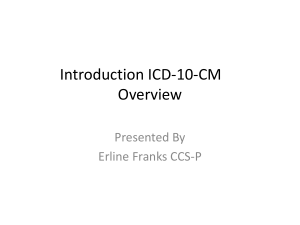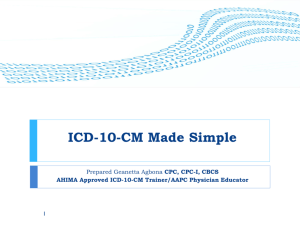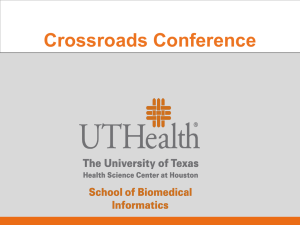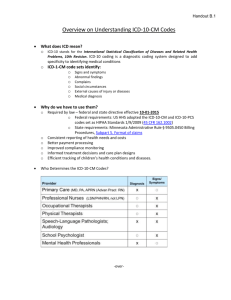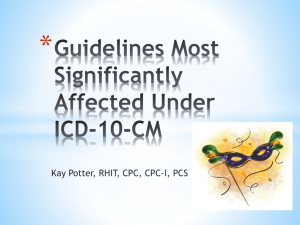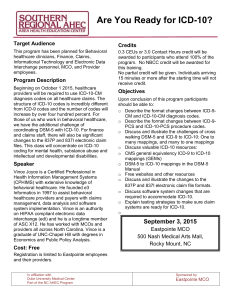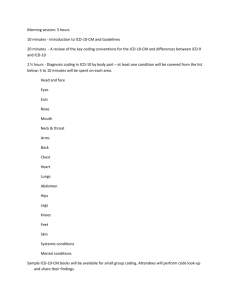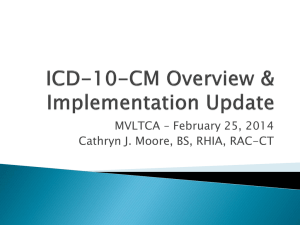ICD-10-CM
advertisement
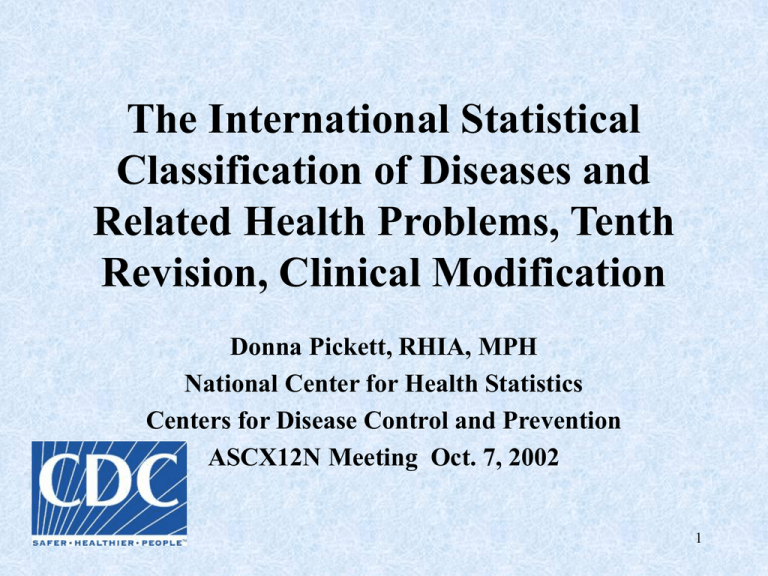
The International Statistical Classification of Diseases and Related Health Problems, Tenth Revision, Clinical Modification Donna Pickett, RHIA, MPH National Center for Health Statistics Centers for Disease Control and Prevention ASCX12N Meeting Oct. 7, 2002 1 The International Classification of Diseases • ICD is the standard used throughout the world for: – Classifying causes of mortality (death registration) – Morbidity statistics • Records and surveys • Health care claims • Basis for prospective payment 2 ICD REVISIONS ICD Revision No. First Year of Year in Use ICD, Clinical Conference in the U.S. Modification When Adopted 1900 1900-1909 Second 1909 1910-1920 Third 1920 1921-1929 Fourth 1929 1930-1938 Fifth 1938 1939-1948 Sixth 1948 1949-1957 Seventh 1955 1958-1967 Eighth 1965 Ninth 1975 1968-1978 ICDA-8 HICDA-1 HICDA-2 1979-1998 ICD-9-CM 1968-1978 1968-1972 1973-1978 1979- Tenth 1989 1999- To be determined ICD-10-CM Year in Use in the U.S. 3 World Health Organization As of July 2000, W.H.O. had authorized the publication of ICD-10 versions in 37 languages, with 30 countries having implemented ICD-10 for mortality and/or morbidity applications. The remainder of the countries were expected to implement ICD-10 before end of 2000. ICD-10 was implemented for mortality reporting in the United States 1/1/99. 4 International Statistical Classification of Diseases and Health Related Problems, Tenth Revision (ICD-10) • Several countries use ICD-10 or a clinical modification in casemix and reimbursement systems – United Kingdom [1995] – Nordic countries (Denmark, Finland, Iceland, Norway, Sweden) [1994-1997] – France [1997] – Australia [1998] – Belgium [1999] – Germany [2000] – Canada [2001] 5 ICD-10 Major Changes ICD-10 represents the broadest scope of any ICD revision to date. Changes include: • • • • Alphanumeric codes (A00-Z99) Restructuring certain chapters/ categories Addition of new features Expansion of detail (2,033 categories; 855 more than ICD-9) 6 Expanded Detail in ICD-10 ICD-9-CM 250 Diabetes – 5th digit “1” identified juvenileonset – 5th digit “0” identified adult-onset ICD-10 • E10 Insulindependent • E11 Non-insulin dependent • E12 Malnutritionrelated • E13 Other specified • E14 Unspecified 7 Injuries Restructured ICD-9 Fractures 800-829 Dislocations 830-839 Sprains/Strains 840-848 ICD-10 Injuries to head Injuries to neck Injures to thorax S00-S09 S10-S19 S20-S29 8 Expanded Detail in ICD-10 External Causes of Injuries ICD-9 (E800-E999) Transport accidents Intentional self-harm Complic. med/surg care E800-E848 E950-E959 E870-E876 ICD-10 (V00-Y98) Transport accidents V01-V99 Intentional self-harm X60-X84 Complic. med/surg care Y40-Y84 9 ICD-10 Evaluation Contract In September 1994 NCHS awarded a contract to the Center for Health Policy Studies (CHPS) to evaluate the International Statistical Classification of Diseases and Related Health Problems (ICD-10). 10 Contract Findings • ICD-10 not significantly better than ICD-9-CM for morbidity applications to warrant implementation. • A clinical modification of the ICD-10 would be a significant improvement and worth implementing. 11 Why a Clinical Modification of ICD-10 ? • Need to: – Expand distinctions for ambulatory and managed care encounters – Expand to include new concepts – Expand to include emerging diseases and more recent medical knowledge – Incorporate changes made to ICD-9-CM since ICD-10 implementation 12 ICD-10-CM Development • Three phases of development Phase 1 -Prototype developed under contract 20 TAP members Phase 2 - Enhancements by NCHS C&M minutes, providers & other users Phase 3 - Further enhancements based on public comments 22 organizations/individuals 13 ICD-10-CM Development • Consultation with: – Physician groups • Dermatology, Neurology, Orthopedics, Pediatrics, Psychiatry, Obstetrics & Gynecology – Professional organizations • ADA, AHA, AHIMA, ANA, NACHRI – Other users of ICD-9-CM • federal agencies, Workers Comp, epidemiologists, researchers 14 ICD-10-CM Major Modifications • Addition of sixth character • Added code extensions for obstetrics, injuries and external causes of injuries (7th character) • Addition of laterality • Created combination diagnosis / symptoms codes • Full code titles 15 ICD-10-CM Major Modifications [continued] • Added trimesters to OB codes (fifth-digits from ICD-9-CM will not be used) • Revised diabetes mellitus codes (5th digits from ICD-9-CM will not be used) • Expanded codes (e.g., injury, diabetes, postoperative complications, alcohol/substance abuse) • Added standard definitions for excludes notes 16 Diabetes mellitus • The common fifth-digit subclassification in ICD-9-CM for diabetes mellitus will not be used in ICD-10-CM • The diabetes categories have been fully revised to reflect the recent revisions to the classification of diabetes issued by the American Diabetes Association 17 Diabetes mellitus [continued] ICD-9-CM ICD-10 ICD-10-CM 250.X 4th digit identities type of complication 5th digit “1” identified juvenile-onset 5th digit “0” identified adultonset E10 Insulin dependent E11 Non-insulin dependent E12 Malnutrition related E13 Other specified E14 Unspecified E08 Diabetes due to underlying condition E09 Drug or chemical induced diabetes E10 Type 1 diabetes E11 Type 2 diabetes E13 Other specified diabetes mellitus E14 Unspecified 4th digit for type of complication 4th digit body system with complication 5/6th digit specifics of 18 complication ICD-10-CM Diabetes mellitus E10.2 Type 1 diabetes mellitus with renal complications – E10.21 Type 1 diabetes mellitus with diabetic nephropathy – E10.22 Type 1 diabetes mellitus with Ebstein's disease – E10.23 Type 1 diabetes mellitus with diabetic renal failure – E10.29 Type 1 diabetes mellitus with other diabetic renal complication 19 ICD-10-CM Diabetes mellitus E10.6 Type 1 diabetes mellitus with other specified complications – E10.61 Type 1 diabetes mellitus with diabetic arthropathy • E10.610Type 1 diabetes mellitus with diabetic neuropathic arthropathy • E10.618 Type 1 diabetes mellitus with other diabetic arthropathy 20 Injury codes in ICD-9-CM & ICD-10 Open wounds – laceration w/foreign body – laceration w/o foreign body – puncture wound w/foreign body – puncture wound w/o foreign body – animal bite Superficial wounds – – – – – abrasion blister contusion external constriction superficial foreign body – insect bite 21 ICD-9-CM Injury Codes 880 Open wound of shoulder and upper arm 880.0 Without mention of complication 880.1 Complicated 880.2 With tendon involvement 5th digit for site (shoulder, axillary, upper arm) 22 ICD-10-CM Expanded Injury Codes Detail for open wounds added at 5th digit: S41.01 Laceration without foreign body of shoulder S41.02 Laceration with foreign body of shoulder S41.03 Puncture wound without foreign body of shoulder S41.04 Puncture wound with foreign body of shoulder 23 ICD-9-CM Decubitus ulcer Decubitus ulcer of back 707.0 Bed sore Decubitus ulcer [any site] Plaster ulcer Pressure ulcer 24 ICD-10-CM Decubitus ulcer expanded codes L89.011 Decubitus ulcer of right upper back limited to breakdown of skin L89.012 Decubitus ulcer of right upper back with fat layer exposed L89.014 Decubitus ulcer of right upper back with necrosis of bone 25 ICD-9-CM Postoperative complications • 998.1 Hemorrhage or hematoma or seroma complicating a procedure • 998.2 Accidental puncture or laceration during a procedure 26 ICD-10-CM Postoperative complications • G97.3 Hemorrhage or hematoma complicating a nervous system procedure – G97.35 Postprocedural hemorrhage of nervous system organ following nervous system procedure – G97.36 Postprocedural hemorrhage of other organ following nervous system procedure 27 ICD-10-CM Postoperative complications • H95.3 Accidental puncture or laceration during an ear procedure – H95.31 Accidental puncture or laceration of the ear during an ear procedure – H95.32 Accidental puncture or laceration of other organ or structure during an ear procedure 28 Poisoning/External Cause ICD-9-CM Accidental poisoning by thyroid hormones 962.7 (Poisoning) Thyroid and thyroid derivatives and E858.0 Accidental poisoning, Hormones and synthetic substitutes 29 Poisoning/External Cause ICD-10-CM Combination Codes • T38.1x1 Poisoning by thyroid hormones and substitutes, accidental (unintentional) • T38.1x2 Poisoning by thyroid hormones and substitutes, intentional self-harm • T38.1x3 Poisoning by thyroid hormones and substitutes, assault • T38.1x4 Poisoning by thyroid hormones and substitutes, undetermined • T38.1x5 Adverse effect of thyroid hormones and substitutes 30 Injury & External Cause Chapter Extensions in ICD-10-CM a Initial encounter d Subsequent encounter q Sequelae 31 Fracture Extensions ICD-10-CM a Initial encounter for closed fracture b Initial encounter for open fracture d Subsequent encounter for fracture with routine healing g Subsequent encounter for fracture with delayed healing j Subsequent encounter for fracture with nonunion q Sequelae 32 Place of Occurrence ICD-9-CM E849.0 Home E849.1 Farm E849.2 Mine and quarry E849.3 Industrial place and premises E849.4 Place for recreation and sport E849.5 Street and highway E849.6 Public building E849.7 Residential institution E849.8 Other specified places 33 Place of Occurrence ICD-9-CM E849.4 Place for recreation and sport Amusement park Baseball field Basketball court Football field Golf course Gymnasium 34 Place of Occurrence ICD-10-CM Y92.0x Non-institutional (private) residence Y92.1x Institutional (nonprivate) residence Y92.2x School, other institution and public administrative area Y92.3xx Sports and athletics area Y92.4xx Street, highway and other paved roadways Y92.5xx Trade and service area Y92.6x Industrial and construction area Y92.7x Farm Y92.8xx Other specified places 35 Place of Occurrence ICD-10-CM • Y92.310 Basketball court as place of occurrence of the external cause • Y92.321 Football field as place of occurrence of the external cause 36 Activity Code ICD-10-CM Activity engaged in when injured Y93.0xx Sports activity Y93.1x Activity primarily requiring repetitive use of fingers, hands and wrists Y93.2x Personal hygiene and household activities Y93.3 Caregiving activities Y93.4x Strenuous physical activities Y93.5x Electronic equipment usage 37 Activity Codes Examples Individual Activity • Y93.010 Running • Y93.013 Horseback riding Group Activity • Y93.020 Football • Y93.022 Baseball 38 Full code titles ICD-9-CM 143 Malignant neoplasm of gum 143.0 Upper gum 143.1 Lower gum ICD-10-CM C03 Malignant neoplasm of gum C03.0 Malignant neoplasm of upper gum C03.1 Malignant neoplasm of lower gum 39 ICD-10-CM Status Complete incorporation of public comments Finalize Tabular List revisions Revise Index & Crosswalks Database (Alpha version) Revise guidelines Develop training materials Pre-release testing/Comparability study 40 41 ICD-10-CM Pre-release Draft on NCHS web site • Pre-release draft, May 2002, ICD-10-CM on NCHS web site at: http://cdc.gov/nchs/icd9.htm • PDF (Adobe) format files: • Tabular • Index • External cause index • Table of Neoplasms The codes in ICD-10-CM are not currently valid for any purpose or uses. 42 ICD-10-CM Comparability Study • New revisions can create discontinuities in trend data • Discontinuities can be measured by comparability ratios – dual coding of data using old & new revision – express results of the comparison as a ratio for a particular cause classified in ICD-10 divided by deaths expressed in ICD-9 43 ICD-10-CM Comparability Study • Assists users of coded data to discriminate between real changes in utilization by diagnosis and those resulting from artifacts of the coding system • ICD-10/ICD-9 comparability study for mortality records (2.3m) nearly completed (preliminary posted on NCHS website) • NCHS conducted study in 1979 when hospitals moved from ICDA-8 to ICD-9-CM 44 Importance of the Improved Clinical Detail • The creation, review and revision of health care policy relies on the availability of accurate and timely health care data generated by both providers and payers of health care and by statistical surveys and other research efforts. • A critical element of these information systems is the classification used to interpret and analyze patients’ diseases and health conditions 45 Uses of ICD-9-CM • • • • • • • • • Tracking national trends - NCHS surveys Tracking state trends - AHRQ HCUP Tracking Medicare trends - Medpar Quality Indicators JCAHO and HEDIS Improved reimbursement (DRGs, APCs) Bench marking Research Public health reporting Strategic planning 46 Disadvantages of Remaining with ICD-9-CM • Due to the classification’s age (20+ years) and content it is no longer clinically accurate • ICD-9-CM update process cannot keep pace with changes • Inability to capture data relating to factors other than disease affecting health • Non-comparability with State/National mortality data • Non-comparability with international data 47 ICD-10-CM Benefits of Enhancements • Comprehensive scope of ICD-10-CM will contribute to: – More relevant data for epidemiological research and decision-support purposes • • • • Patient safety (medical errors) Ambulatory/managed care encounter Surveillance & prevention activities Outcomes research 48 ICD-10-CM Benefits of Enhancements • Comprehensive scope of ICD-10-CM will contribute to: – Increased sensitivity when making refinements in applications such as grouping and reimbursement methodologies – Reduction in additional information being forwarded to payers to adjudicate claims 49 ICD-10-CM Benefits of Enhancements • Harmonization with DSM-IV • Chapter 2 (Neoplasms) and morphology codes correspond to ICD-O-2 which have been used by cancer registry programs since 1995 • Harmonization (90-95%) with NANDA nursing classification • Greater flexibility to add new codes • Reflects current usage of medical terminology 50 ICD-10-CM Implementation Issues • Training: – Will be required for various users at various levels – Should not require extensive coder retraining • Structure, conventions, coding rules basically the same – Some short-term loss of productivity is expected during the learning curve • Changes to data systems & software – Groupers, encoders, payment policy, performance measurement systems • Changes in data retrieval/analysis 51 ICD-10 Implementation Experience in Other Countries • Concerns: – Resources, cost of training, timing • Training: – – – – – 2-3 day workshops for coders (new and experienced) For clinicians, software suppliers and others In HIM programs Post implementation workshops Six month learning curve • Changes in data retrieval/analysis – Crosswalks, database versions 52 HIPAA and ICD-10-CM Implementation The Administrative Simplification (AS) provisions of Health Insurance Portability and Accountability Act of 1996 (HIPAA) are intended to reduce the costs and administrative burdens of health care by making possible the standardized, electronic transmission of many administrative and financial transactions that are currently carried out manually on paper. 53 HIPAA and ICD-10-CM Implementation • Implementation of ICD-10-CM tied to the standards adoption process specified in the Administrative Simplification provisions of HIPAA (1996) – – – – Public hearings Notice of Proposed Rulemaking (NPRM) Public comment period Final rule 54 NCVHS Standards & Security Subcommittee Hearings on Replacements to ICD-9-CM • Conducted public hearings on ICD-10-CM and ICD-10-PCS – 4/9/02 – 5/29/02 ICD-10-PCS ICD-10-CM 55 NCVHS Standards & Security Subcommittee Hearings on Replacements to ICD-9-CM • IT Vendors and Provider Panel 5/29/02 – Cerner, McKesson, 3M HIS, Gambro, Tenet HealthSystems • Industry-wide challenge but doable • Recommended 2-3 year lead-time for implementation of new code sets • 3 of the 5 testifiers have experience with implementation of ICD-10 in other countries 56 NCVHS Standards & Security Subcommittee Hearings on Replacements to ICD-9-CM • There is an urgent need to begin the process to move to newer and better standards for diagnoses and procedures • Replacing ICD-9-CM is essential, but it will take time & resources to implement system changes that will be required 57 NCVHS Subcommittee on Standards & Security Hearings Findings • The replacement of the diagnosis and procedure classifications should occur simultaneously • Some stakeholders believe there is a need to more fully explore issues related to costs, timing, & resources before publishing an NPRM 58 8/29/02 NCVHS Subcommittee on Standards and Security • Additional testimony was provided • NCVHS Subcommittee on Standards and Security agreed to forward a recommendation to the full NCVHS – Propose that the Secretary of HHS issue an NPRM for US adoption of ICD-10-CM and ICD-10-PCS (inpatient only). – NPRM should include an in-depth impact analysis of the change – Any change should not be required before October 2005. 59 8/29/02 NCVHS Subcommittee on Standards and Security • Subcommittee further recommended the NPRM allow those commenting to: – Comment on options of how and when HHS would implement these coding standards – Review cost estimates of such implementations – Provide their own studies related to costs of implementation and value of making such a coding change 60 9/25/02 NCVHS Full Committee • NCVHS considered approval of the Subcommittee’s recommendation of issuance of NPRM for ICD-10-CM and ICD-10-PCS including: – Requirement of full impact analysis – Invites comments from the public – Requires the department to respond to the public comments • No action taken on letter 61 11/19-20/02 NCVHS Full Committee • NCVHS to hear presentation by Standards & Security Subcommittee of issues related to migrating to ICD-10-CM and ICD-10PCS including: – Pertinent background information – Intricacies of issues • timing; cost/benefit analysis 62 Web Site NCHS Classification Home Page: ICD-9-CM, ICD-10, ICD-10-CM, and ICF http://www.cdc.gov/nchs/icd9.htm National Committee on Vital and Health Statistics: http://ncvhs.hhs.gov/ 63
